TOP 7 Food Scanner Apps for iPhone (2025)
Okay, real talk—reading food labels sucks.
There are too many weird names, hidden stuff, and ingredients no one understands.
Like… what even is sodium benzoate?
If you’ve ever looked at the back of a packet and felt confused, you’re not alone.
That’s where food scanner apps come in.
You just scan the barcode, and they tell you if it’s good, bad, or somewhere in between.
Some apps even warn you about added sugar, fake colors, or stuff you might be trying to avoid.
I’ve tried a bunch, and not all of them are worth your time.
So in this guide, I’m sharing the best ones I’ve found.
Let’s check them out.
You might be surprised what’s really in your snacks.
What I Use with Food Scanner Apps
- Food Scale – So I don’t just guess how much I’m eating. See on Amazon
- Label Magnifier – Helps me read those tiny nutrition labels. See on Amazon
- Reusable Grocery List Pad – I write down what to avoid or buy. See on Amazon
1. Yuka – I Like It the Most

Pros:
- Super clean and easy to use
- Gives a score out of 100 for each product
- Flags harmful additives instantly
- Suggests better alternatives
Cons:
- Not all products are in the database (especially smaller brands)
- Doesn’t break down calories or macros
Alright, so here’s the thing—Yuka makes label reading stupid simple.
You scan a barcode, and it gives you a score right away (0 to 100).
But it’s not just a number.
It breaks it down by nutrition, additives, and if it’s organic or not.
What I love is how visual it is.
Like, no need to dig into long reports or scroll endlessly.
You’ll see green for “good,” orange for “meh,” and red if it’s packed with stuff your body’s gonna hate later.
And if something’s not great?
Yuka straight up shows you better options.
It even scans cosmetic products, by the way—so if you’re into clean beauty too, bonus.
I usually scan stuff with Yuka and then toss the good ones into my grocery list app so I don’t forget them when I’m actually at the store.
Now yeah, it doesn’t show calories or track your meals (this isn’t a calorie counter).
But if you just wanna eat better and stop buying stuff with shady ingredients, this app’s a beast.
It’s my go-to.
Worth trying if: You want fast, clear answers about what’s in your food.
Skip if: You’re only looking to count calories or log meals.
Also read: Best water reminder apps
2. Bobby Approved – Best for Clean Ingredient Scanning

Pros:
- Flags bad ingredients with red labels
- Backed by a real person
- Easy to understand for beginners
- Suggests clean, better swaps
Cons:
- Focuses only on ingredients, not full nutrition info
- Might feel too strict if you’re not fully into clean eating
The Bobby Approved app is kinda like shopping with a health nut friend who knows everything.
You scan a barcode, and it instantly tells you if the product has sketchy stuff—like artificial sweeteners, seed oils, preservatives, or fake flavors.
Anything Bobby wouldn’t eat? It’s marked red, no confusion.
The best part? You don’t need to be a health expert.
Bobby keeps it real and explains why something’s bad in simple words.
Plus, if a product’s not “approved,” the app shows better options you can grab instead.
Super helpful if you’re standing in the aisle like, “Okay… now what?”
I will say—this app is strict.
So if you’re more chill with ingredients, it might feel a bit intense.
But if you’re trying to clean up your pantry, or just stop falling for sneaky marketing like “all natural,” this one’s solid.
Worth trying if: You want quick, no-BS ingredient breakdowns.
Skip if: You’re looking for full calorie or macro tracking.
3. Read the Labels – Best for Beginners

Pros:
- Crazy simple to use
- Highlights good, okay, and bad ingredients
- Great for beginners who feel overwhelmed by labels
- No sign-up or login needed
Cons:
- Database isn’t as huge as others
- Doesn’t give health scores or alternatives
Read the Labels does exactly what the name says.
It helps you read and understand food labels without needing a science degree.
You scan a product, and it shows you a quick list of ingredients, each one marked as good, okay, or bad.
It doesn’t flood you with numbers or fancy charts.
Instead, it gives you short, straight-up explanations like “This is linked to gut issues” or “Used for flavor but may cause allergies.”
So even if you’ve never Googled an ingredient in your life, this app’s got you.
It’s perfect if you’re just starting out with clean eating or trying to avoid processed junk.
The design is simple, and there are no sign-ups or annoying ads popping up everywhere.
Now, it won’t give you a nutrition score or tell you how many calories are in your cereal.
But that’s not its job.
It’s here to keep labels honest and help you make quick calls at the store.
Worth trying if: You just want to know if an ingredient is good or bad.
Skip if: You want in-depth nutrition breakdowns or scanning alternatives.
4. Open Food Facts – Best for Deep Label Transparency

Pros:
- Massive database with global products
- Shows Nutri-Score, Eco-Score, and NOVA rating
- 100% free, no ads
- Open-source and powered by real users
Cons:
- Interface looks a bit outdated
- Some info can be incomplete or crowd-sourced
If you like digging deep into what’s in your food, Open Food Facts is your jam.
It’s not backed by a brand or influencer.
It’s an open-source project run by people who care about real food transparency.
Scan a product, and it’ll hit you with all the details:
- Nutri-Score (A to E for health)
- Eco-Score (environmental impact)
- NOVA rating (how processed it is)
The app also breaks down things like sugar, fiber, saturated fat, and additives.
And it explains everything in plain English.
So whether you’re trying to eat clean, lower your carbon footprint, or avoid ultra-processed stuff, this app gives you the full picture.
Now yeah, it’s not the prettiest app out there.
And since it’s community-powered, some products might be missing info.
But for a free app with zero ads and loads of detail?
It punches way above its weight.
Worth trying if: You’re into transparency, sustainability, and label deep-dives.
Skip if: You prefer flashy design and polished UI.
5. LabelCheck – Best for Quick & Clear Label Breakdown

Pros:
- Very clean and easy layout
- Gives instant breakdowns of nutrition, additives & minerals
- Works fast, no sign-up needed
- Great for checking how processed a food is
Cons:
- Smaller database (some products might not show up)
- Doesn’t offer food alternatives
If you want something super straightforward with zero fluff, LabelCheck delivers.
It’s one of those apps that just works.
You scan a product, and right away, it gives you a full picture: nutrition score, processed level, calorie count, minerals, and even the additives inside.
Everything’s laid out in neat little sections, so you don’t have to scroll around or guess what anything means.
It uses clear tags like “Too Processed” or “OK in Moderation,” and if something’s actually decent?
You’ll know right away.
Now, it’s not as popular as some of the big names, so the product list isn’t endless.
But for basic stuff you find in most stores, it holds up well.
And honestly, it feels good using something that’s all signal, no noise.
Worth trying if: You want fast, clear answers without logging in or digging through ads.
Skip if: You’re looking for community reviews or swap suggestions.
6. Processed – Best for Spotting Ultra-Processed Foods

Pros:
- Tells you exactly how processed a food is
- Uses clear categories (ultra, processed, minimally, whole)
- Clean and modern UI
- Simple language, no techy terms
Cons:
- Doesn’t show full nutrition info
- Database is still growing (might miss niche products)
Processed doesn’t care about calories, carbs, or macros.
It cares about what’s been done to your food.
And honestly? That’s refreshing.
You scan a barcode, and it instantly tells you if the item is ultra-processed, just a little processed, or something close to whole food.
It’s perfect if you’re trying to clean up your diet but don’t wanna get into the weeds of numbers.
The app uses a smart AI system to rate each item, and it’s surprisingly accurate, even for packaged stuff you’d never expect to be ultra-processed.
The design is super clean, and it’s crazy easy to use.
It doesn’t overwhelm you with info.
Just gives you the one thing you opened the app for: “Is this real food or fake food?”
Once I started paying attention to what’s actually in my food, I realized I needed to get my meals sorted, too.
I’ve been using this meal planner app, and honestly, it just makes the whole “eating better” thing feel less all over the place.
Only downside? It’s still growing.
So don’t expect every random product to be in the system.
But for common snacks, pantry staples, and frozen items?
It works great.
Worth trying if: You want to avoid ultra-processed food without counting calories.
Skip if: You need a full breakdown of nutrition labels.
7. Trash Panda – Best for Avoiding Fake Stuff in Snacks

Pros:
- Flags added sugar, fake flavors, food dyes, etc.
- Great for people with food allergies or sensitivities
- Super beginner-friendly
- Shows you cleaner options
Cons:
- Not super detailed with nutrition info
- Name might throw people off (but it’s memorable as hell)
Trash Panda might sound like a joke, but it’s actually one of the most helpful apps out there if you’re trying to dodge the junk.
You scan your snack or cereal, and the app instantly checks for stuff like artificial dyes, added sugars, seed oils, preservatives—you know, the things that quietly mess with your body.
What I love is that it doesn’t just say “bad” or “good”.
It breaks down why an ingredient might be a red flag.
Like, it’ll straight up tell you, “This dye has been linked to hyperactivity in kids,” or “This sweetener can mess with your gut.”
And for every trashy item?
It usually gives you better, cleaner swaps.
It’s not trying to be everything.
No calorie tracking, no deep macro stuff.
Just a no-nonsense tool for spotting food that’s full of fake stuff and cutting it out of your life.
The moment you cut out all the junk, you kinda start asking—okay, so what can I eat now?
That’s when I started using this recipe app.
Nothing fancy.
Just real food stuff I’ll actually make.
You can check it out if you want to.
Worth trying if: You care about clean ingredients and want fast red-flag alerts.
Skip if: You need a detailed nutrition breakdown or meal logging.
My Final Take
Look, you don’t need to be a nutritionist to eat better.
You just need the right app in your pocket.
Food scanner apps make things stupidly simple.
You scan, you get the truth, and you decide what goes in your cart (or back on the shelf).
If I had to pick one? Yuka is still my go-to.
It’s fast, clean, and gives you the full story in seconds.
But honestly, all these apps do one thing really well: they help you stop guessing and start choosing smarter.
So yeah—next time you’re holding a “healthy” granola bar that has 34 ingredients, pull out your phone and scan it.
You might be surprised what’s actually in there.
FAQs
1. What is the best app to scan food labels for ingredients?
If you’re looking for something super easy that flags bad ingredients and explains why they matter, Bobby Approved or Read the Labels are both solid picks. They’re beginner-friendly and don’t overwhelm you with numbers.
2. Are food scanner apps actually accurate?
Mostly, yeah. Apps like Yuka and Open Food Facts pull from verified databases or use AI with clear scoring systems. That said, not every product is listed, especially small brands, so take it as a guide, not gospel.
3. Do food scanner apps count calories too?
Some do (like Yuka shows basic nutrition), but most of the apps in this list aren’t calorie counters. If you want food scanning + calorie tracking, check out something like MyFitnessPal—but that’s a different type of app.



